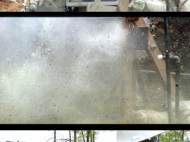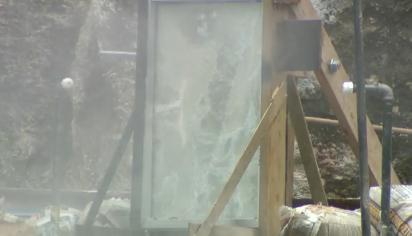Better blast-resistant glass with a layer of fibers embedded in plastic
 To protect from potential terrorist attacks, federal buildings and other critical infrastructures are made with special windows that contain blast-resistant glass. However, that kind of glass is thick and expensive. Researchers at University of Missouri are developing and testing a new type of blast-resistant glass that will be thinner, lighter and less vulnerable to small-scale explosions. Future tests will be done on larger pieces of glass that are equivalent to standard window size, and researchers could potentially test the glass on large-scale explosions.
To protect from potential terrorist attacks, federal buildings and other critical infrastructures are made with special windows that contain blast-resistant glass. However, that kind of glass is thick and expensive. Researchers at University of Missouri are developing and testing a new type of blast-resistant glass that will be thinner, lighter and less vulnerable to small-scale explosions. Future tests will be done on larger pieces of glass that are equivalent to standard window size, and researchers could potentially test the glass on large-scale explosions.
Conventional blast-resistant glass is made with laminated glass that has a plastic layer between two sheets of glass. Sanjeev Khanna, a associate professor at mechanical and aerospace engineering in the MU College of Engineering, and Zhen Chen, a civil and environmental engineering professor, are now replacing the plastic layer with a transparent composite material made of glass fibers that are embedded in plastic. The glass fibers add strength because, unlike plastic, they are only about 25 microns thick, which is about half the thickness of a typical human hair, and leave little room for defects in the glass that could lead to cracking.
“Currently, blast-resistant window glass is more than 1 inch (2.5cm) thick, which is much thicker than standard window glass that is only one-fourth of an inch thick and hurricane-protected window glass that is one-half of an inch thick,” said Khanna. He added: “The glass we are developing is less than one-half of an inch thick. Because the glass panel will be thinner, it will use less material and be cheaper than what is currently being used.”
In tests, the researchers observed how the glass reacts to small-scale explosions caused by a grenade or hand-delivered bomb. They tested the glass by exploding a small bomb within close proximity of the window panel. After the blast, the glass panel was cracked without holes in the composite layer.
“The use of a transparent composite interlayer provides us the flexibility to change the strength of the layer by changing the glass fiber quantity and its orientation”, Khanna said.
With that success in hand, Khanna and Chen also plan to study whether using nanoparticles-the name given to microscopic materials so small that their natures change-could strengthen the adhesion between different layers. “That bonding between layers plays a large role in whether or not glass breaks upon impact”, Chen said.
“The new multilayered transparent glass could have a wide range of potential uses if it can be made strong enough to resist small-scale explosions,” Khanna said. “The super-strong glass also may protect residential windows from hurricane winds and debris or earthquakes. Most hurricane damage occurs when windows are punctured, which allows for high-speed wind and water to enter the structure.”










Leave your response!